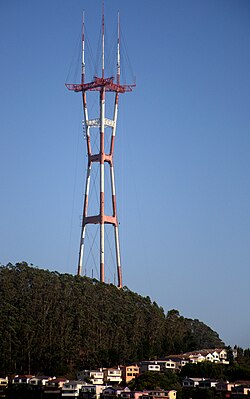Sutro Tower
| Sutro Tower | |
|---|---|

Sutro Tower viewed from Grandview Park in San Francisco
|
|
| General information | |
| Status | Complete |
| Type | Radio mast |
| Location | San Francisco, California |
| Address | 1 La Avanzada Drive Clarendon Heights |
| Coordinates | 37°45′19″N 122°27′10″W / 37.7552°N 122.4528°WCoordinates: 37°45′19″N 122°27′10″W / 37.7552°N 122.4528°W |
| Elevation | 254.2 m (834 ft) |
| Completed | July 4, 1973 |
| Owner | Sutro Tower, Inc. |
| Height | |
| Antenna spire | 297.8 m (977 ft) |
| Observatory | on Level 6, 228.8 m (751 ft) above base |
| Dimensions | |
| Other dimensions |
|
| Technical details | |
| Structural system | Truss tower |
| Design and construction | |
| Architect | Furman L. Anderson, Jr. |
| Architecture firm |
|
| Renovating team | |
| Engineer | Simpson Gumpertz & Heger |
| Website | |
| sutrotower |
|
| References | |
Sutro Tower is a 977 ft (298 m) three-pronged TV and radio antenna tower in San Francisco, California. Rising from a hill between Twin Peaks and Mount Sutro near Clarendon Heights, it is a prominent feature of the city skyline and a landmark for city residents and visitors.
Before the construction of Sutro Tower in 1973, television reception in San Francisco was spotty because the many hills of the city blocked the line-of-sight television signal. The great height of the new tower helped to resolve that problem. Transmitters had been scattered throughout the Bay Area, including at San Bruno Mountain, Mt. Allison, Monument Peak, and Mt. Diablo. By having all the main Bay Area television station transmitters in one location, reception was improved by allowing a receiving antenna pointed in a single direction to receive all those stations rather than a subset.
Local residents opposed the tower even before it was completed, including criticism of the aesthetic effect the tower would have on the rest of San Francisco. San Francisco writer Herb Caen once wrote, "I keep waiting for it to stalk down the hill and attack the Golden Gate Bridge." Acknowledging both displeasure and affection for its undeniable prominence on the city's skyline, it is sometimes referred to light-heartedly as the Sutro Monster or Space Claw.
When first built, the long legs of the tower were illuminated at night with long tubes of white light that looked like long fluorescent tubes. However, public outcry resulted in the lights being removed soon after they were turned on.
Despite the initial revulsion of some residents, Sutro Tower is now recognized by many as a Bay Area icon, it appears in local art, television shows, and movies as one of the architectural symbols of the city. The tower is featured in video games, business logos, on clothing, as furniture and even tattoos. The U.S. band Information Society used it on the cover of their album Don't Be Afraid. A local entertainment guide, SF Station, uses it as a logo, as does the collaborative art game SFZero and the Expose SF art competition.
...
Wikipedia

